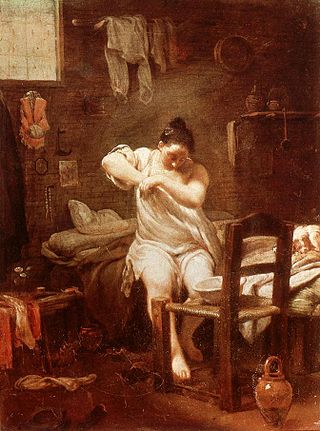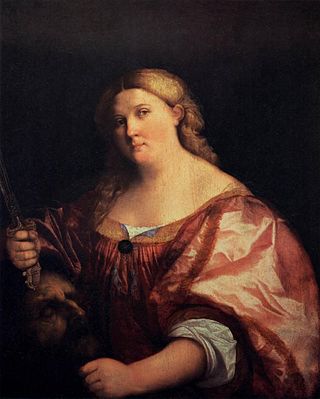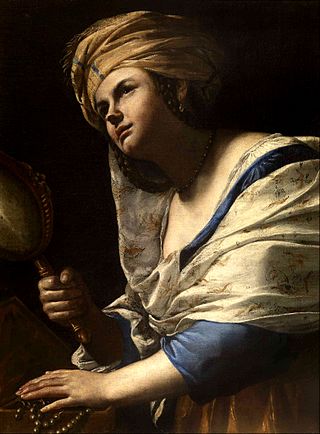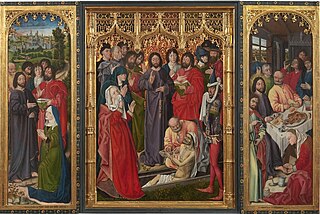
The Cispadane Republic was a short-lived client republic located in northern Italy, founded in 1796 with the protection of the French army, led by Napoleon Bonaparte. In the following year, it was merged with the Transpadane Republic to form the Cisalpine Republic. The Cispadane Republic was the first Italian sovereign State to adopt the Italian tricolour as its flag.

Teodulo Mabellini was an Italian composer.

Giovanni Raboni was an Italian poet, translator and literary critic.
Antonio Bueno was an Italian painter of Spanish origin, who acquired Italian citizenship in 1970. He was born in Berlin while his journalist father was posted there by the newspaper ABC of Madrid.

Juti Ravenna was an Italian painter.

Tricolour Day, officially National Flag Day, is the flag day of Italy. Celebrated on 7 January, it was established by Law 671 on 31 December 1996. It is intended as a celebration, though not a public holiday. The official celebration of the day is held in Reggio Emilia, the city where the Italian tricolour was first adopted as flag by an Italian sovereign state, the Cispadane Republic, on 7 January 1797.

Alessandro Felici was an Italian composer and violinist, not to be confused with his contemporary, Roman composer Felice Alessandri.

The Libro de' Disegni was a collection of drawings gathered, sorted and grouped by Giorgio Vasari whilst writing his Lives of the Most Excellent Painters, Sculptors, and Architects. By the time of his death in 1574 it is thought to have contained around 526 drawings, of which 162 are now in the Louvre and 83 in the Nationalmuseum, Stockholm. There are also drawings from the Libro in the prints and drawings departments of the Uffizi, the British Museum, the Albertina, the National Gallery of Art and other institutions.

Allegory of Happiness is an oil on copper painting by Bronzino, probably first produced for the Studiolo of Francesco I, signed BROZ. FAC. and now in the Uffizi in Florence. It is now in a fluted and gilded 17th century wooden frame. Most art historians date it to around 1567, and it is first mentioned in the Uffizi inventory in 1635/8.

The Child Bitten by A Lobster is a drawing by the Italian painter Sofonisba Anguissola, executed in chalk and pencil on light blue paper, and dated to around 1554. It is in the collection of the Museo di Capodimonte, in Naples.

Madonna and Child with Saint Catherine of Alexandria is a c.1550 oil on panel painting by the studio of Titian, now in the Galleria degli Uffizi. It was restored around the end of the 18th century, when the present carved and gilded frame was probably added.

Self-Portrait Aged 71 is an 1862 oil-on-canvas painting by the Italian artist Francesco Hayez. The Uffizi had been requesting a self-portrait from him since 1858 via Andrea Appiani's daughter-in-law Giuseppina Appiani Strigelli and it finally arrived in 1863. It is still in the Uffizi's Vasari Corridor.
Corrado Govoni. was an Italian poet. His work dealt with modern urban representations, the states of memory, nostalgia, and longing, using an expressive and evocative style of writing.

Woman Searching for Fleas, The Flea or Woman Getting out of Bed is a 1710-1730 oil on copper painting by Giuseppe Maria Crespi, a painter from Bologna. The main version is now in the collection of the Uffizi in Florence, whilst variants survive, including one at the Museo nazionale di palazzo Reale in Pisa, also originating in the Guardaroba of the Grand Dukes of Tuscany.

The Adoration of the Magi with Saint Helena is an oil painting on canvas of c. 1525–1526 by Palma Vecchio in the Pinacoteca di Brera, Milan.

Judith is an oil on panel painting, attributed to Palma Vecchio, and created in 1525-1528. It is held in the Uffizi, in Florence. The attribution to Palma Vecchio was questioned in the past but is now usually accepted. Art historians Giovanni Battista Cavalcaselle and Joseph Archer Crowe have attributed it to Palma Vecchio, also identifying damage from heavy-handed cleaning, especially on the head of Holofernes. This attribution has been confirmed by György Gombosi and Giovanni Mariacher, who identified it as a mature work of that artist.

Madonna and Child with Saints is a c. 1520 oil on panel painting by Palma Vecchio, now in room XVI of the Accademia Carrara in Bergamo, the artist's birthplace. It is first recorded as part of the collection of Guglielmo Lochis, who acquired it in 1830 from Cristoforo Orsetti, one of the most important Venetian collectors of that era.

Vanitas is an oil-on-canvas painting executed ca. 1650–1670 by the Italian artist Mattia Preti, now inventory number 9283 in the Uffizi in Florence, for which it was bought in 1951 from a private collection. Art historians diasgree on whether the painting is a fragment of a larger work or retains its original dimensions, as well as whether it is a general vanitas or depicts Mary Magdalene.

The Raising of Lazarus is a 1461 three-panel oil on oak panel altarpiece by the French painter Nicolas Froment, now inventory number 1065 in the Uffizi Gallery in Florence, which restored it in 2017.

















